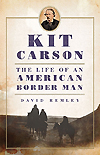
Kit Carson: The Life of an American Border Man, by David Remley, University of Oklahoma Press, Norman, 2011, $24.95
“Ask people who Kit Carson was,” David Remley posits in the preface to this new biography. “Most suspect that he was not the great white hero of dime novels, but a real border man of some sort—a trapper, a guide, a hunter, a mountain man, a frontiersman. Some think that he was good and that he was larger than life, others that he was just a killer, even genocidal.” Dime novelists in the 19th century saddled Christopher Houston “Kit” Carson with the nicknames “Nestor of the Plains” and “Terror of the Plains,” among other hyperbolic handles. Modern-day revisionists have termed him “trigger happy” and a “natural born killer.” Remley has thoughtfully sifted through the existing scholarship on Carson to find neither myth nor monster but a man more nuanced than either extreme. “My hope,” says the author, “is to stimulate more careful and balanced thought, speech and writing about Kit.”
Born in Kentucky on Christmas Eve 1809 and raised in Missouri, Carson ran away from a saddlery apprenticeship at age 16 and never let the dust settle long on his feet after that. For the next four decades he roamed the United States from coast to coast as a fur trapper, guide, dispatch rider and Army scout. He was married twice to Indian women and, finally, to lifelong love Josefa Jaramillo, the daughter of a prominent Mexican family in Taos. Kit shared campfires with explorers Ewing Young and John Frémont, served in the Indian wars and Civil War under noted officers Stephen Kearny and Edward Canby and rubbed elbows, albeit anxiously, with presidents and statesmen. Such professional associations brought the plainspoken Carson uneasy fame.
Remley repeats the oft-told account of Kit’s 1849 pursuit of a Jicarilla raiding party that had captured settler Ann White, her daughter and her servant. Carson guided a detachment of dragoons to the raiders’ camp, but an abortive attack cost White her life. “The body of Mrs. White was found, perfectly warm,” Carson recalled years later. “In camp was found a book [Charles Averill’s Kit Carson, the Prince of the Gold Hunters], the first of the kind I had ever seen, in which I was made a great hero, slaying Indians by the hundred, and I have often thought that as Mrs. White would read the same, and knowing that I lived near, she would pray for my appearance and that she would be saved.” Later shown a copy of Averill’s book, Carson reportedly snarled to “burn the damn thing.”
A particular strength of Remley’s approach is the author’s own curiosity not just about his subject but also the time, places and circumstances in which Carson lived. Early detailed passages about America’s Scots-Irish heritage, saddlery tools and techniques, log homes and the Indian mindset at first seem disconnected asides but actually serve to frame the broader narrative of Carson’s life to come. It was a big life, often marked by tragedy, sometimes at Kit’s own hand. Remley is adept at capturing the conflict between Carson’s inborn sense of duty and loyalty and his personal moral code.
Remley makes no apologies for those episodes of violence that marked Kit’s path, but he does provide welcome context. “In reality,” he writes, “border life and warfare were almost never as simple as ‘the whites’ against ‘the Indians’ as portrayed in the movies and so much popular literature.” Still there would be blood. Carson himself was blunt about one particular vengeful attack on a Klamath village: “The number killed I cannot say. It was a perfect butchery.” Remley is just as blunt in his modern-day assessment: “It was an example of retributive justice at its most violent and most primitive, a punishment based on unconfirmed reports, then rationalized as a means of teaching a lesson.” But then the context: “People of all sides made war for these reasons over the many years of American border conflict. Though the killing rituals themselves could be very elaborate, such warfare was, to put it mildly, not only crude, but ultimately ineffectual as a means of practicing ‘justice.’” Ironically, the episodes for which revisionists vilify Carson—the burning of Navajo peach orchards in Canyon de Chelly and the “Long Walk” of the Navajos to New Mexico’s Bosque Redondo—were not on his watch. He had gone home to be with Josefa.
But the quiet life was not to be. The Army roped Kit into duty several more times before his death on May 23, 1868, one month after Josefa died in childbirth. They had been married a quarter century, much of that time apart.
—Dave Lauterborn




